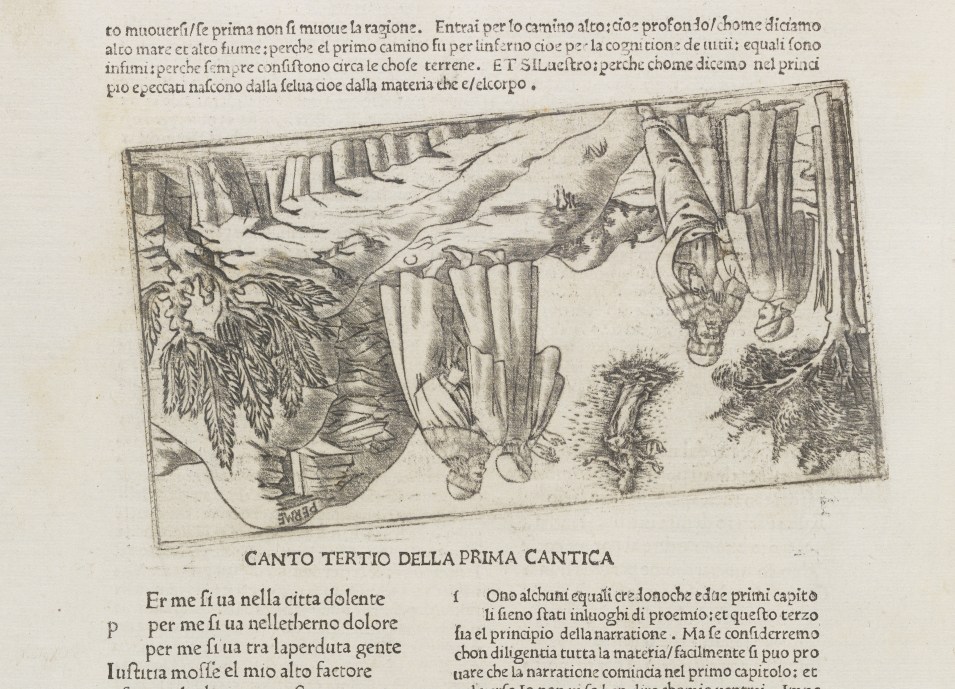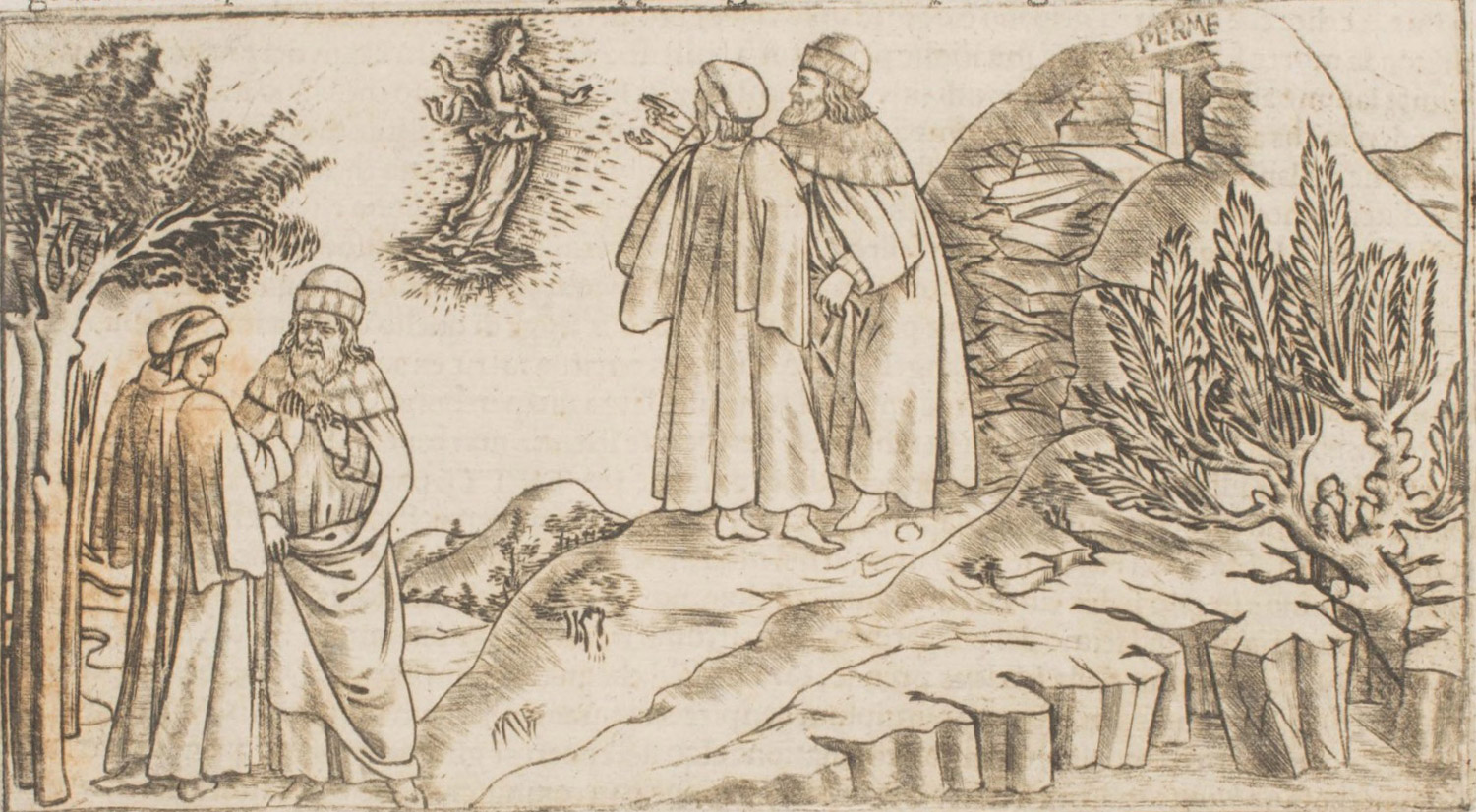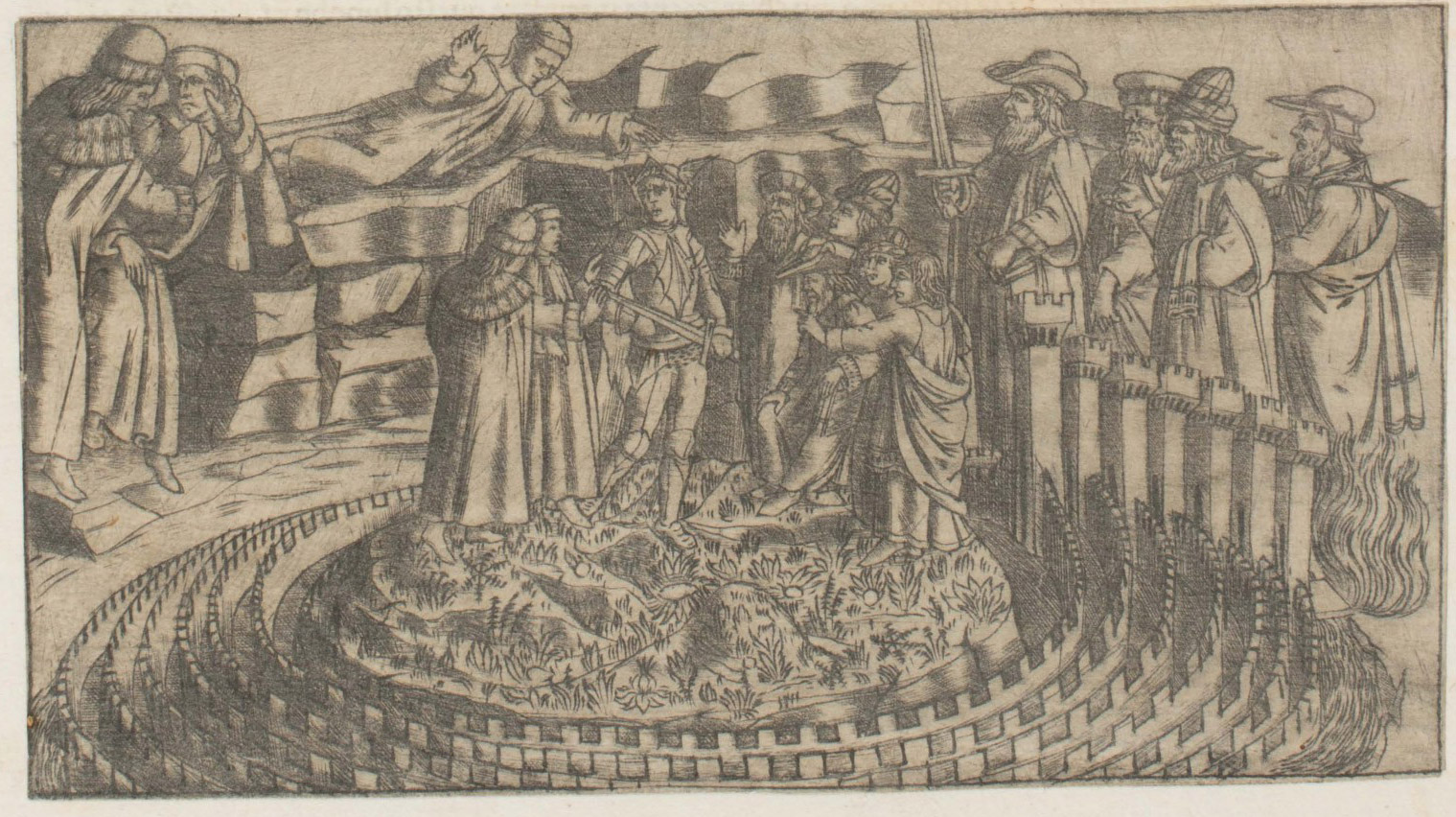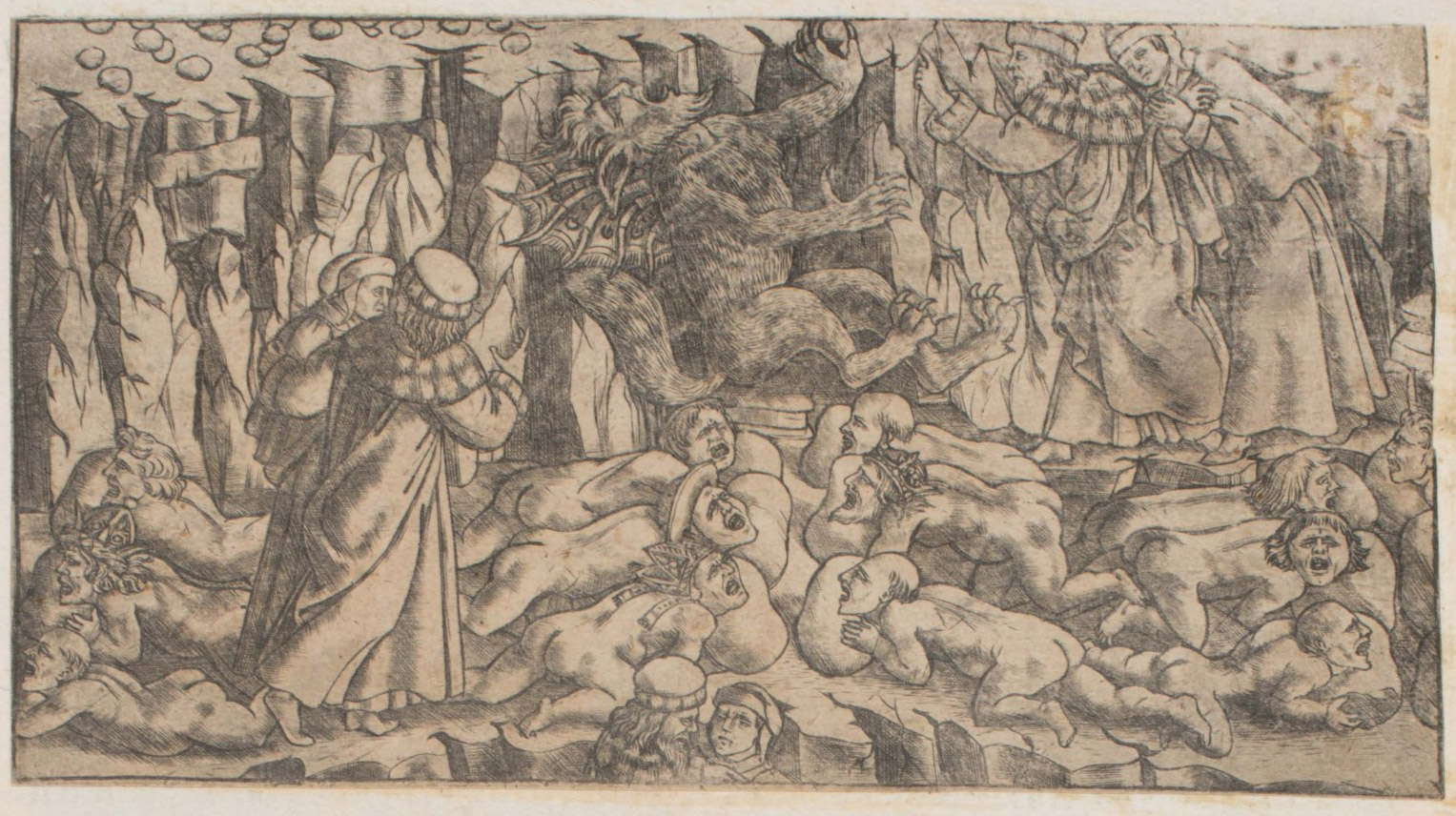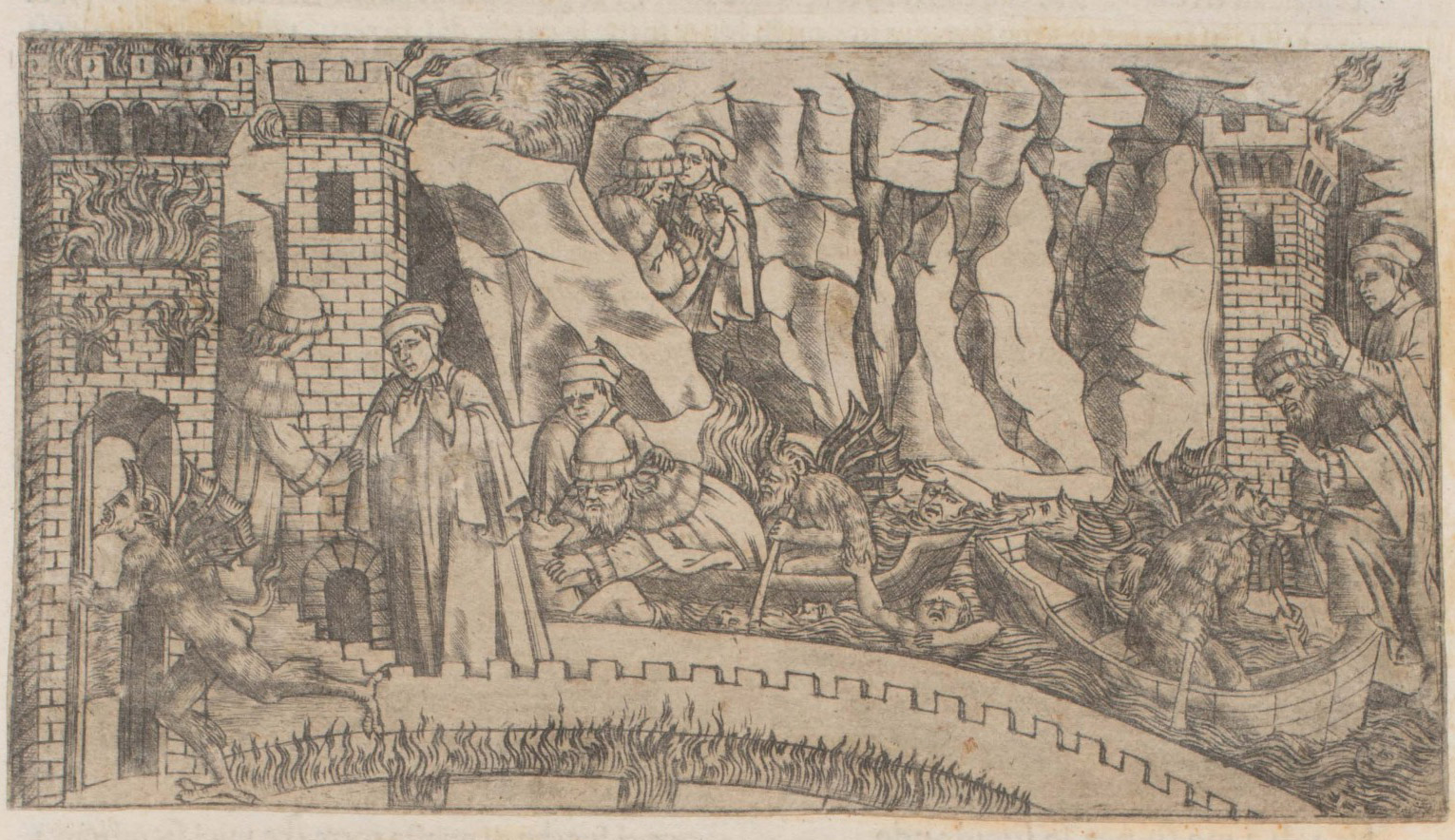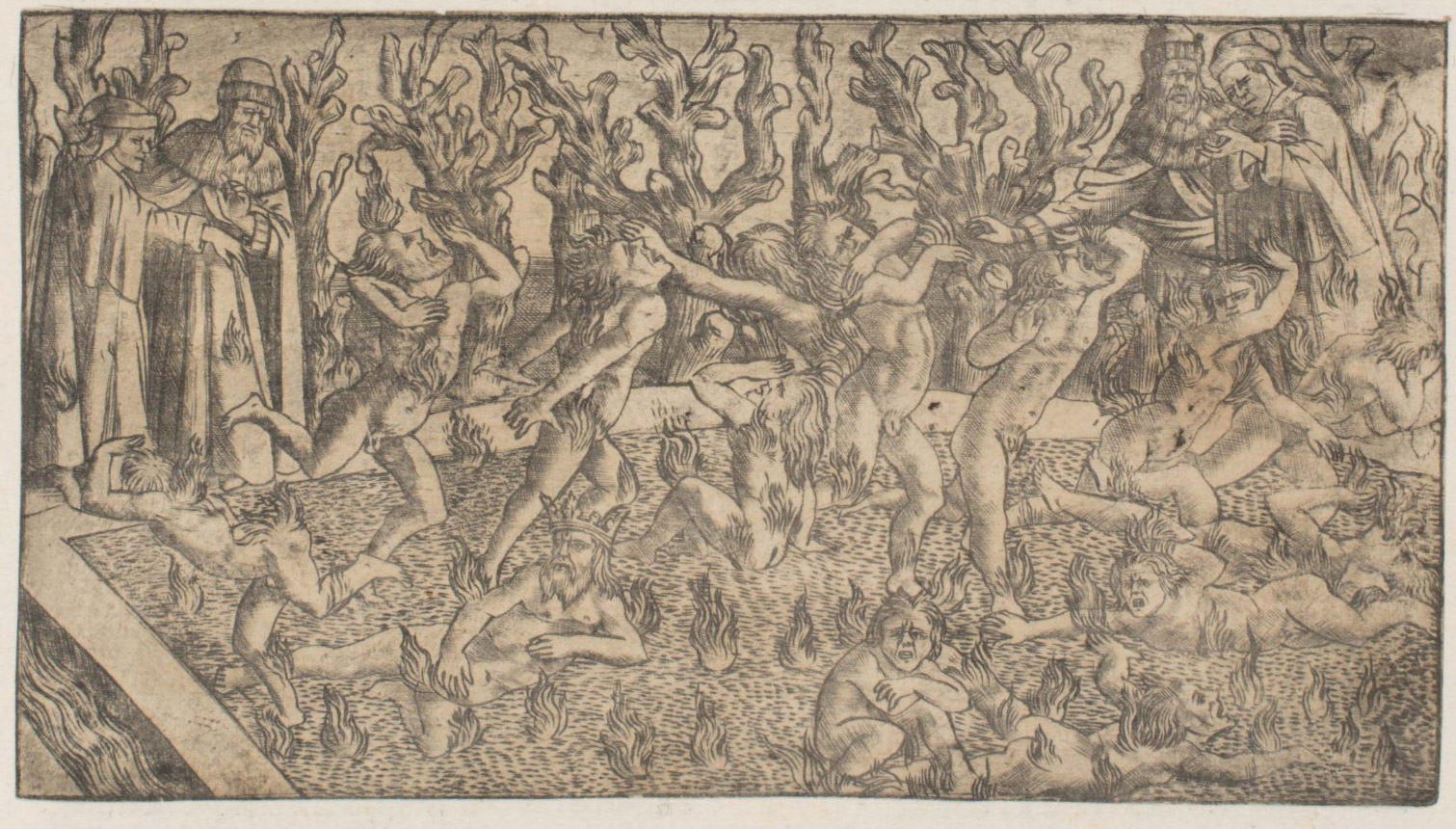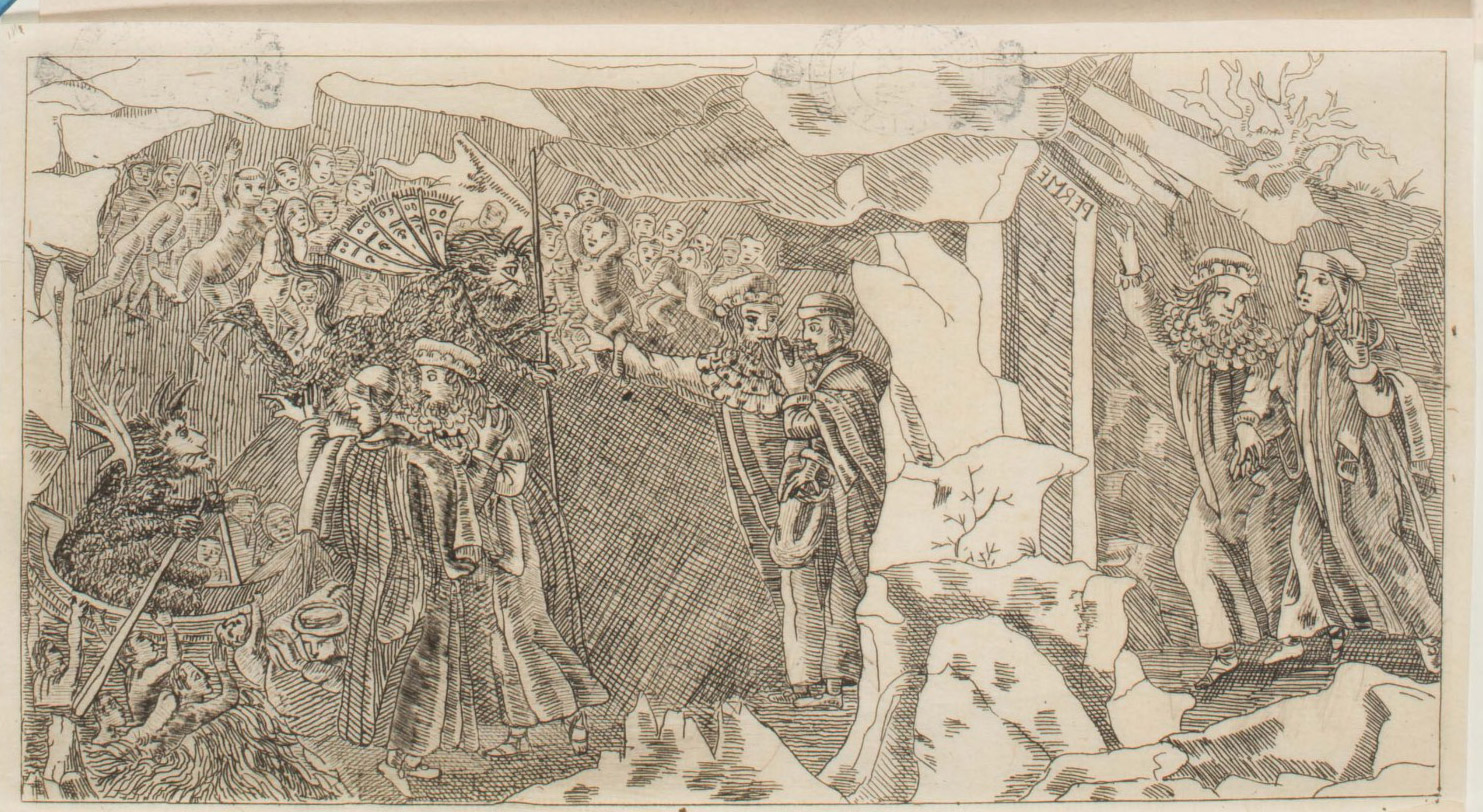Printing Revolution 1450-1500. Fifty Years that Changed Europe
Dante 1481
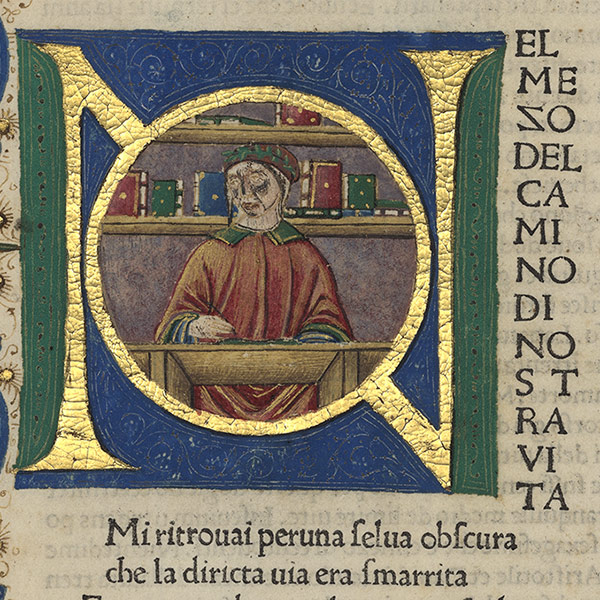
Printing R-Evolution 1450-1500. Fifty Years that Changed Europe
Dante 1481
Printing the Comedia in 1481
The Comento di Christophoro Landino fiorentino sopra la Comedia di Danthe, printed in Florence by Niccolò di Lorenzo della Magna and completed on 30 August 1481, as the colophon tells us, is a folio edition, printed on Royal paper imported from Fabriano, consisting of 372 leaves, and containing illustrations of episodes from the Comedia designed by Sandro Botticelli and engraved on copper-plates by Baccio Baldini.
The engravings were intended to accompany each of the 100 cantos of the three canticles (Hell, Purgatory, Paradise), and to be printed with the text. Of these, however, only 19 in total were produced, of which only the first 2/3 (in some copies the engraving of Canto 2 is repeated before the beginning of Canto 3) were inserted in the printed page, while the remaining 17 were printed on separate sheets, cut out and pasted in. Not in all copies, however: as will be seen in the section below dedicated to the engravings, there are also copies which contain no illustrations.
A copy of the original contract for the edition was recently discovered by Lorenz Böninger in the State Archives in Florence. The document contains the names and the roles of the individuals involved in the company, the number of copies which were to be printed, the schedule for the work, and the rules that had to be followed, both in the production of the book and then in its marketing.
The contract states that on 24 December 1480
‘I, Cristoforo son of Bartolomeo Landini, Doctor in civil law, and Bernardo son of Antonio son of Ricciardo Alberti (cousin and heir of Leon Battista Alberti), and master Niccolò di Lorenzo della Magna printer in the district of Sant’Ambrogio of Florence, have got together to form a company to print the three comedies of Dante with the commentary newly written by the aforementioned Cristoforo’.
The contract stipulated:
- strict conditions for the protection of Landino’s work, almost in terms of intellectual property rights;
- a commitment from Landino to deliver to the printer Niccolò di Lorenzo in installments all the parts of the text to be printed and/or to correct the proofs;
- that the printer should print ‘the three Comedies’ (i.e. Hell, Purgatory and Paradise) simultaneously on three separate presses, ‘one sheet per day per istrectoio (i.e. per press) to the total of three presses and the daily production of three sheets’. We also need to take into account, however, that, as Neil Harris has shown, the type of press used by Niccolò di Lorenzo for his Dante edition was still the so-called ‘one-pull’ press, with a fixed top, which could print only one page at a time;
- that every evening the new proofs were to be taken to Cristoforo Landino and Bernardo degli Alberti for correction, and returned the next morning to the printer;
- that the print-run of the edition was to be 1125 copies;
- that Bernardo degli Alberti would finance the enterprise, with a recoverable loan of ‘three hundred and sixty fiorini larghi (i.e. large florins)’;
- that individual copies were to be sold for 3 florins;
- that all earnings from the sale of the copies, after the sum required to pay off the loan was deducted, would be divided into three equal parts.
Botticelli’s drawings and Baccio Baldini’s engravings
The contract and the commission to produce the engravings
Although the first edition of Landino’s Commentary was intended from the beginning to be illustrated, the promoters of the initiative did not immediately agree on how the book should be illustrated. The series of engravings which would illustrate Dante’s text, in fact, is mentioned only in passing in the contract drawn up on 24 December 1480. The only indication provided by the document regarding the ‘storie’ (i.e images) is that they were to be paid for by Bernardo degli Alberti.
What the contract enables us to assume, however, is that at the time it was signed, an engraver who would take on the job had not yet been identified, and that the responsibility for finding one was subsequently entrusted to the printer, Niccolò di Lorenzo della Magna.
Whatever the case, the plan was to provide an extensive set of images illustrating the entire Comedia. This is clear from the fact that the printer left empty spaces in each single canto, with the intention of inserting the corresponding engravings. There are three cantos (Purgatory Canto 24 and 25, Paradise Canto 30) in which no space was left, but this was probably by mistake.
The author of the engravings
It was the biographer Giorgio Vasari (1511-1574) who recorded that Sandro Botticelli ‘illustrated the Inferno and had it printed’, thus revealing the collaboration between the painter and the engraver Baccio Baldini, who, ‘not having much skill in drawing, did everything using the invention and design of Sandro Botticello’. Most scholars agree in associating these comments by Vasari to the project of illustrating the Florentine edition of Landino’s Dante commentary. According to this version of the facts, therefore, Botticelli was responsible for producing the drawings, on the basis of which Baldini then engraved the copper-plates.
The attribution to Botticelli of the drawings for the engravings of the 1481 edition is strengthened by their closeness to the cycle of drawings shared today between the Kupferstichkabinett in Berlin and the Vatican Apostolic Library. The two cycles have undeniable compositional and iconographic affinities, although the style of the engravings is decidedly more archaic. Heinrich Schulze Altcappenberg, noting the uneven character of the engravings, has hypothesized that Baldini did not actually work on Botticelli’s final drawings, but instead on a miscellaneous collection of preliminary studies and perhaps some sketches. This procedure would have been necessary when Botticelli was not in Florence because he was engaged with commissions elsewhere.
Another possibility, proposed by Alessandra Baroni, is that the entire project is to be attributed to Baccio Baldini. The scholar, not convinced by the stylistic distance between the Berlin-Vatican cycle and that in the 1481 edition, admits the possibility that Botticelli’s drawings were available to Baldini, but believes that the proximity between the drawings and the engravings is mainly due to the use of common sources. Baroni sees in the series of copper-plates a greater affinity with the tradition of manuscript illustration in Florence in the fourteenth and fifteenth centuries, and thinks that both Baldini and Botticelli may have been influenced by the fourteenth-century Florentine images already derived from the Comedia.
The chronological period within which the project was carried out is generally agreed by scholars. Work on the engravings probably began shortly after the beginning of 1481. A letter attached to the dedication copy sent to Bernardo Bembo, dated to 1484, indicates that at that time the copper-plates for the first two cantos had been made, and that in some copies the copper-plate for Canto 2 had been repeated. Since it is highly improbable an incomplete copy had been sent to Bembo, it must be assumed that in 1484 the project to illustrate the entire poem was abandoned. Only later did the other 17 illustrations continue to be engraved, to be pasted into the white spaces the printers had reserved for them. The production of the engravings must have stopped by 1487, the year in which Baldini died and, above all, in which a new edition of the Comedia appeared, printed in Brescia by Bonino Bonini. This edition is accompanied by 68 woodcuts which, in iconographical terms, indicate that the engraver had studied Baldini’s 19 copper-plates.
Printing and its complications
Niccolò della Magna and Baccio Baldini were responsible for the introduction in Florence of the technique of engraving on copper-plate with a burin, even before the more widespread technique of wood engraving (woodcut) was first used there.
The printer, evidently still in a phase of experimentation, started printing the illustrations by adopting a rather unusual procedure. The copper-plate was printed directly onto the empty space reserved for it on the printed page. This technique had only been used once in the past, also on this occasion for some engravings attributed to Baldini and printed in Niccolò’s workshop: these are the three plates of Monte Sancto di Dio by Antonio Bettini from Siena, published in 1477 (GW 2204; ISTC ia00886000).
The choice of printing the copper-plates onto the printed page presented some challenges. First of all, the printers needed to consider the different resistance of the lead type and of the copper-plate, which reacted differently to the pressure of the platen and meant that the printer was obliged to pass the page twice under the press.
The resistance of the paper was further tested by the fact that, in order for the intaglio ink to adhere in the best way possible, the sheet with the printed text had to be moistened.
In addition, the decision to print the copper-plate onto a sheet which had already been printed with the text did not allow for corrections when the plate had been wrongly positioned. In copies of this Dante edition it is not in fact uncommon to find the first two engravings to be crooked or, in one case (Oxford, Bodleian Library), placed upside down.
After printing the first two engravings (and in very few copies also the third) with this procedure, Niccolò was not satisfied with the results. His dissatisfaction is also shown by the fact that the parchment copy presented to the Signoria of Florence, now in the National Central Library of Florence, does not contain any engravings. The technical difficulties undoubtedly caused the progress of the project to slow down, as well as a chronological division in production: while the printing of the text of the book continued, the insertion of the engravings using this method was paused after attempts to include the first two or three.
The copper-plate illustrations for the subsequent 17 cantos of Hell were printed on separate sheets, which were then sometimes cut to size and pasted into the corresponding blank spaces.
The interruption of the production of the engravings
As already mentioned, the series of illustrations for the 1481 Comento was interrupted at Canto 19 of Hell, although the initial idea had been much more ambitious. The reasons for the decision to halt production are not known, but it is possible to make some hypotheses as to why it was taken.
The first possibility is that the series was discontinued owing to economic difficulties encountered by the printer. Records of Niccolò della Magna are scarce after the printing of the De re aedificatoria by Leon Battista Alberti in 1485 and the Moralia by Gregory the Great in 1486, during a period in which Piero Scapecchi believes that the printer was forced out of business owing to the debts he had accumulated.
Another probable explanation is that the decision to end production of the illustrations was due to the slowness with which Baldini supplied the engravings. In support of the idea, there is the fact that, while the first two engravings were printed in brown ink, the others use various colours. This detail suggests that there were pauses in the execution of the plates, which perhaps extended until 1487. As mentioned above, this was the year in which Bonino Bonini published an illustrated edition of the Comedia, after the one printed in Venice by Ottaviano Scoto in 1484 which however had only illustrated initials. The commercial competition represented by these two new editions made it disadvantageous to continue investing in illustrating the 1481 edition. In addition, we must remember that Baccio Baldini died in 1487, leaving the series incomplete.
The states of the engravings and Hind’s classification
All the engravings, except the first two, appear in two states. The second state is characterized by the addition of Arabic numbering, as well as by the presence of a variant of the engraving for Canto 3.
The variant of the third engraving would seem contemporary to the rest of the series, so it could be an alternative version designed by the same artist. There is, however, something dry in the quality of the engraving, a feature that has left some uncertainty among scholars. Therefore, the possibility cannot be excluded that it may have been engraved by a craftsman other than Baccio Baldini.
The presence of two states opens up a possible scenario for the next phase in the history of the illustrations, suggested by Alessandra Baroni. Given the decline of Niccolò della Magna’s activity around 1486, it is conceivable that the 19 copper-plates were already complete around that date and, due to the cessation of della Magna’s activity or his death, they passed into the hands of another printer. On this occasion they would have been given a new numbering and would have been sold separately to be pasted into the empty spaces of the already bound volumes.
Given the troubled history of this edition and the different number of engravings contained in each copy, the Keeper of the Department of Prints and Drawings in the British Museum, Arthur M. Hind, developed a classification scheme to describe each of the categories into which surviving copies (the ones known to Hind at the time) could be divided.
The first category, which is by far the most numerous, contains the engravings of Canto 1 and 2, printed directly onto the printed page.
The second category includes copies which contain the engravings of Canto 1 and 2, as well as a repeat of the engraving of Canto 2 before the beginning of Canto 3. All three are printed directly onto the printed page.
The third category comprises copies which contain the engravings of Canto 1, 2 and 3 printed directly onto the printed page. This variant is only present in copies with the complete set of engravings.
The fourth category is for copies which contain all 19 illustrations, sometimes with the second state of the engraving of Canto 3. The prints are pasted onto the page, with the exception of those described in the first three categories.
The fifth category is for copies which contain a varying number of engravings, more than 3 but fewer than 19. The engravings of Canto 1 and 2 (and sometimes 3) are printed directly onto the printed page, while the subsequent images are pasted in.
The copy kept at the John Rylands University Library is the only one to contain 20 engravings, because a second copy of the engraving of Canto 3 has been added to the complete series.
Who purchased and read the Comedia?
Of the 1125 printed copies, 180 or 16% survive today. This is an above average survival rate for books printed in this period, certainly due to the large format, the fame of the author, and the illustrations.
The examination of all the surviving copies, now held in 135 libraries in Europe, the United States, Japan, and Brazil, has allowed us to reconstruct the history of the circulation and use of the edition during the first 100 years after printing, and the subsequent interest on the part of collectors from all over the world.
But at the beginning it was a publishing project with an almost exclusively local – Florentine and Tuscan – distribution.
Documents show that quite a few copies remained unsold and that in one case, in 1496, 140 volumes were purchased for the low cost of one florin per copy. An example of this group could be the copy that is kept in the Roberto Ridolfi Collection in Florence, which has a note saying ‘This book belongs to Benedetto di Mariano [Tempi] who purchased it on 24 October 1496 for 1 Florin’. This devaluation in price can be explained by the arrival on the Italian market of other editions, which were costed more competitively and were also more complete in terms of text and illustration.
Despite the continuous appearance of new editions of Dante’s work in print, copies of the 1481 Florence edition, kept in booksellers’ warehouses, continued to be sold for a long time.
After the death of Niccolò di Lorenzo, sometimes after 1485, the unsold copies left in the warehouse may have been dispersed and passed in part to the leading Florentine booksellers of the period between the fifteenth and sixteenth centuries, the Giunti, who still had copies of the edition in their warehouses in 1604. Thus this proves that the edition remained on sale for at least 135 years or more after its first appearance, which may explain the problems it immediately caused from a commercial point of view.
Printing in Florence in the fifteenth century
In terms of the number of editions printed in the fifteenth century (= incunabula) in Italy, Florence ranks fourth, after Venice, Rome, and Milan. To date, 892 editions survive, compared to 3786 in Venice, 2096 in Rome and 1141 in Milan (Incunabula Short Title Catalogue). However, it should be noted that it is very difficult to establish a definite number of editions for Florence, for various reasons. There were many printed editions without the name of the printer and/or without date. The identification of these elements is made difficult because the distinctive types found in them were used for a long time and also passed frequently into the hands of different printers, as indeed did illustrative material.
Vernacular titles constitute at least 77% of the surviving Florentine production, compared with the 32% survival rate of vernacular editions of the entire existing printed production during the fifteenth century, approximately 28,500 editions. This high figure of production in the vernacular can be explained by the fact that Florentine printers were aware that they were unable to produce for export and therefore had to focus on local consumption (Trovato p. 58), which incidentally was very high, especially that of low-cost and mass-consumption. An example is the printing house run by the nuns of the convent of San Jacopo a Ripoli and its production of devotional works and popular literature distributed by the city’s stationers and pedlars, most of which no longer survive (Conway). Furthermore, looking at the number of leaves in each surviving edition printed in the city, we find that there are only 24 which consist of more than 200 leaves. Those consisting of over 100 leaves are also very few. 70% of the production consists of editions with fewer than 52 leaves and of these 320 are booklets made up of 2 to 12 leaves: predictions for the new year, extracts from poems in the vernacular, devotional texts such as Mystery Plays and the sermons of Girolamo Savonarola.
What was printed in Florence in the fifteenth century
Florence published very few classical editions, no works of jurisprudence concerning the ius canonicum and the ius civile, and no Bibles, but editions of the often richly illustrated Sacre Rappresentazioni (Mystery Plays) were numerous.
In 1476, a few years therefore before the printing of the Comedia, the local Strozzi family wanted to print an edition of Pliny’s work on Natural History, with which Cristoforo Landino was also involved, as translator. They commissioned the expert Venetian printer Nicolas Jenson to carry out the work, with spectacular results (Edler de Roover). Filippo Strozzi’s copy illuminated by the Florentine artists Gherardo and Monte di Giovanni di Miniato, is held today in the Bodleian Library in Oxford.
As for the authors of Florentine fifteenth-century editions we find Boccaccio, Petrarch, Domenico Cavalca, the Pulci brothers, Cristoforo Landino, and Angelo Poliziano, but Girolamo Savonarola is by far the most printed author in Florence in this period, with 118 editions. Towards the end of the century, some 13 works in Greek were also published.
There were only two editions of Dante’s works (or ten if we include the eight editions of the Credo which was then commonly attributed to him), the first edition of the Convivio of 1490 and the Divine Comedy of 1481. The latter was the eighth edition of the poem in chronological order, preceded by the Foligno princeps of 1472, one from Mantua, three from Venice, one from Milan and one from Naples.
Why Dante was not printed before 1481 in Florence
The delay in producing an edition of Florence’s foremost poet was certainly in part due to his bitter attacks on his native city, found in all three canticles.
In Canto 15 of Hell Dante puts the following words into the mouth of his old tutor Brunetto Latini (verses 61-78):
‘But that ungrateful, malicious people who came down from Fiesole of old, and still smack of the mountain and the granite, will become your enemies because of your just actions; and that is reasonable, for among the sour crab apples it is not fitting that the sweet fig bear its fruit. Ancient fame in the world calls them blind; they are a people avaricious, envious, and proud: see that you keep yourself clean of their customs.
Your fortune holds so much honour in store for you, that both sides will hunger for you; but let the grass be far from the goat. Let the Fiesolan beasts make straw of each other, but let them not touch the plant, if any still sprout in their manure, in which may live again the holy seed of the Romans who remained there when that nest of so much malice was built.’
While Canto 26 opens with the famous invective
‘Rejoice, Florence, since you are so great that on sea and land you beat your wings, and your name spreads through Hell! Among the thieves I found five such citizens of yours that I feel shame, and you do not rise to honour by them. But if near morning one dreams the truth, you will feel, a short time from now, something of what Prato, not to speak of others, desires for you; and if it had already come, it would not be early. Would it already were, since it must come! for it will weigh on me more, the older I grow’.
Dante was forced into exile and never returned to Florence. After his death, his body was not returned to his native city but was buried in Ravenna.
Dante with the commentary of Landino, Florence 1481
The commentary by Cristoforo Landino is part of a trend which began in the second half of the fifteenth century, aimed at creating a cult of the figure of Dante, together with constructing an Apologia for Florence and a pro-Medici orientation.
Landino wishes to vindicate with Dante and for Dante the literary and civic tradition of Florence. This desire is expressed in the solemn and at the same time impassioned dedication to the city’s rulers, in Landino’s introduction to the text and his commentary, and in the long Apologia in which he defends ‘Dante and Florence from false calumniators’ and lists famous Florentines who excelled in learning, eloquence, music, painting and sculpture, jurisprudence, and commerce. All this is reinforced by the inclusion in the Florentine edition of a short text by Marsilio Ficino, who promoted the idea that the figure of Dante should be recovered for Florence, text which was inserted by Landino as part of the Proemio to his commentary. Ficino’s text is presented first in Latin and then in Italian, and it ‘mirrors a cultural predilection, which fits well within the Landinian Proemio, dedicated as this is to the exaltation of Tuscan and in particular Florentine culture’ (S. Gentile, 2001, p. 114-118).
After its appearance as part of the 1481 edition Landino’s exegesis would go on to predominate throughout the fifteenth century. As we have seen, this was the first printed edition of the Comedia in Florence and there had not been an authoritative commentary on the poem produced in the city since Boccaccio had begun one in the fourteenth century. Of the 15 fifteenth-century editions of the Comedia, no fewer than 7 include Landino’s commentary. It was reprinted a total of fourteen times between the late fifteenth and the sixteenth century. 13 of these editions with Landino’s commentary were Venetian and one was published in Brescia, and between them they amounted to approximately 10,000 copies. As Simon Gilson has written, ‘reading Dante in the sixteenth century meant reading him with the eyes of Landino’. The success of Landino’s commentary would also continue into the seventeenth century.
Bibliography
Hein-Th. Schulze Altcappenberg, ‘”Per essere persona sofistica” il ciclo botticelliano per la Divina Commedia’, in Sandro Botticelli. Pittore della Divina Commedia, catalogo della mostra (Roma) (Ginevra, Skira, 2000), II, pp. 14-35
Alessandra Baroni, ‘L’autore delle incisioni del Comento e la controversa figura di Baccio Baldini’, in Per Cristoforo Landino lettore di Dante: il contesto civile e culturale, la storia tipografica e la fortuna del Comento sopra la Comedia. Atti del convegno internazionale, Firenze 7-8 novembre 2014 (Firenze, Casa editrice Le Lettere, 2016), pp. 155-173
Lorenz Böninger, ‘Il contratto per la stampa e gli inizi del commercio del Comento sopra la Comedia’, in Per Cristoforo Landino lettore di Dante: il contesto civile e culturale, la storia tipografica e la fortuna del Comento sopra la Comedia. Atti del convegno internazionale, Firenze 7-8 novembre 2014, a cura di Lorenz Böninger e Paolo Procaccioli (Firenze, Casa editrice Le Lettere, 2016), pp. 97-118
Lorenz Böninger, Niccolò di Lorenzo della Magna and the social world of Florentine printing, ca. 1470-1493 (Cambridge and London, Harvard University Press, 2021), pp. 75-82; 122-124 (contratto)
Elisa Brilli, ‘Landino apologeta: Dante e Firenze col senno di poi’, in Per Cristoforo Landino lettore di Dante: il contesto civile e culturale, la storia tipografica e la fortuna del Comento sopra la Comedia. Atti del convegno internazionale, Firenze 7-8 novembre 2014, a cura di Lorenz Böninger e Paolo Procaccioli (Firenze, Casa editrice Le Lettere, 2016), pp. 175-194
Melissa Conway, The Diario of the Printing Press of San Jacopo di Ripoli 1476-1484. Commentary and transcription, Storia della tipografia e del commercio librario, 4 (Firenze, Olschki, 1999)
Carlo Dionisotti, ‘Landino, Cristoforo’, in Enciclopedia Dantesca (1970), in Enciclopedia Italiana
Florence Edler de Roover, ‘Come furono stampati a Venezia tre dei primi libri in volgare’, Bibliofilia, 55 (1953), pp. 107-17
Simon A. Gilson, ‘La fortuna del Comento landiniano nel Cinquecento: lettori e commentatori danteschi’, in Per Cristoforo Landino lettore di Dante: il contesto civile e culturale, la storia tipografica e la fortuna del Comento sopra la Comedia. Atti del convegno internazionale, Firenze 7-8 novembre 2014, a cura di Lorenz Böninger e Paolo Procaccioli (Firenze, Casa editrice Le Lettere, 2016), pp. 175-194
Neil Harris, Recensione a Per Cristoforo Landino lettore di Dante: il contesto civile e culturale, la storia tipografica e la fortuna del Comento sopra la Comedia. Atti del convegno internazionale, Firenze 7-8 novembre 2014, a cura di Lorenz Böninger e Paolo Procaccioli (Firenze, Casa editrice Le Lettere, 2016), in The Library 20 (giugno 2019), pp. 246-248
Arthur M. Hind, Early Italian Engraving. A critical catalogue with complete reproduction of all the prints described (Nendeln, Kraus Reprint, 1970), pp. 100-107
Peter Keller, ‘Die Kupferstiche zur Ausgabe der «Göttlichen Komödie» von 1481’, in Sandro Botticelli Der Bildenzyclus zu Dantes Göttlicher Komödie (London, Royal Academy of Arts, 2000), pp. 326-333
Cristoforo Landino, Comento sopra la Comedia, a cura di Paolo Procaccioli (Roma, Salerno, 2001)
Elisa Squicciarini, ‘Il commento di Landino alla Commedia: l’edizione Marchiò Sessa e le annotazioni del Tasso’, in Natura Società Letteratura, Atti del XXII Congresso dell’ADI – Associazione degli Italianisti, Bologna, 13-15 settembre 2018, a cura di Andrea Campana e Fabio Giunta (Roma, Adi editore, 2020)
Piero Scapecchi, ‘Cristoforo Landino, Niccolò di Lorenzo e la Commedia’, in Sandro Botticelli. Pittore della Divina Commedia, catalogo della mostra (Roma) (Ginevra, Skira, 2000), I, pp. 44-47
Piero Scapecchi, ‘Esemplari conservati della Comedia impressa da Nicolò di Lorenzo (1481)’, in Per Cristoforo Landino lettore di Dante: il contesto civile e culturale, la storia tipografica e la fortuna del Comento sopra la Comedia. Atti del convegno internazionale, Firenze 7-8 novembre 2014, a cura di Lorenz Böninger e Paolo Procaccioli (Firenze, Casa editrice Le Lettere, 2016), pp. 195-199
The Divine Comedy of Dante Alighieri: Inferno, edited by Robert M. Durling (Oxford University Press USA – OSO, 1996)
Paolo Trovato, ‘Il libro in Toscana nell’età di Lorenzo’, in id., L’ordine dei tipografi. Lettori, stampatori, correttori tra Quattrocento e Cinquecento (Roma, Bulzoni, 1998), pp. 49-89
Barbara J. Watts, ‘Sandro Botticelli’s Drawings for Dante’s Inferno: Narrative Structure, Topography and Manuscript Design’, Artibus et Historiae, 32 (1995), vol. 16, pp. 163-201
The illustrated copy census
In April 2021, to mark the 700th anniversary of Dante’s death in 1321, the Consortium of European Research Libraries (CERL) began an illustrated census of the copies of this edition, funded by the Polonsky Foundation. Having ascertained the number of copies recorded in the ISTC and GW databases, which amounted to 166 volumes held in 130 libraries around the world, we began by contacting each library with a request to provide not only information on the history of the copy or copies in their possession, but also images of marks of provenance and other use: bindings, decorations, ownership notes, ex-libris and stamps, and marginal or interlinear notes. The CERL network was fundamental in the success of the operation, which, quite remarkably, was carried out and concluded over a period of just three months (April-June 2021), and came to include 180 copies from 135 libraries. The fact that libraries with limited expertise in early printed Italian books were able to send images and leave their interpretation and historical research to us was crucial in gaining the almost total adhesion of all the holding institutions involved, such as the Loyola Marymount University in Los Angeles, the Meiji University Library in Tokyo, or the National Library of Belarus.
Private collections not yet recorded in ISTC and GW, which have come to our attention, have generally been happy to participate in the census, such as the library of the Castle of Castiglione del Terziere, or the collection of Livio Ambrogio in Milan.
Marina Venier was in charge of liaising with libraries and the collection of data and images; Camilla Marangoni oversaw the data entry into the database Material Evidence in Incunabula (MEI), the uploading of the images to the Provenance Digital Archive (PDA) of CERL, and of the illustrations in the 1516 database; Venier and Marangoni also prepared the text of the webpage and identified the relevant verses for the video ‘Botticelli interpreter of Dante’.
The MEI files have also been completed with references to the specialist bibliography linked to this particular edition with its variable number of engravings, namely the work of Arthur Hind and Paolo Procaccioli.
This research project, made possible by a collective effort coordinated by CERL, is offered as a model of the possibility we have today of making illustrated censuses which offer crucial insights into the distribution and uses that have been made, both by contemporaries and over the course of later centuries, of a certain edition, or work or author, or indeed the output of a printer. Research that in the past occupied the life of an individual scholar for decades – think of the 30 years spent by Owen Gingerich in compiling his census of copies of Copernicus’ De Revolutionibus – and which today can instead be the subject of a master’s or doctorate or, as in this somewhat unusual case of the CERL project, the intense work of a few months. Today we can more easily produce this kind of research, which is important for the advancement of our knowledge and fascinating for the public, thanks to the attention to copy-specific data in cataloguing, to digitization, to the creation of digital tools such as MEI and the PDA for the integrated collection of data and images, to the ease of communication via email, and to the sense of community nurtured by associations such as CERL, a community of intent and fact, between libraries, and between libraries and university researchers.
The Polonsky Foundation Dante Project is dedicated to the libraries that have so enthusiastically shared their collections in this illustrated census, and to all readers of Dante.
Cristina Dondi, Secretary of CERL
Funded by

Coordinated by



![Immagine digitale da BEIC (Roma, Bibl. Corsiniana), carte [*]4r, n8v, p7r](http://www.printingrevolution.eu/wp-content/uploads/2021/08/corsininiana_bg.jpg)
